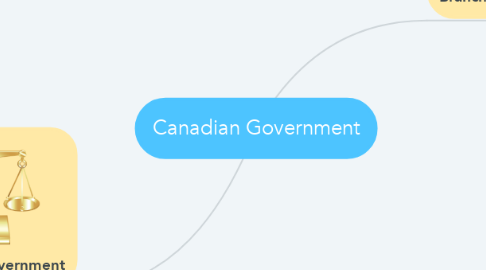
1. Shared Responsibilities
1.1. Transportation
1.2. Energy
1.3. Human Rights
1.4. Elections
1.5. Immigration
2. Levels of Government
2.1. Federal
2.1.1. Given the most power
2.1.2. Responsible for matters dealing with all of Canada
2.1.3. Responsibilities
2.1.3.1. National Defense
2.1.3.2. Federal Court
2.1.3.3. Immigration and Citizenship
2.1.3.4. Residual Powers
2.1.3.5. Taxes
2.1.3.5.1. Income Tax
2.1.3.5.2. Sales Tax
2.1.3.6. Territorial Governments
2.2. Provincial
2.2.1. Responsibilities
2.2.1.1. Education
2.2.1.2. Hospitals
2.2.1.3. Municipal Governments
2.2.1.4. Children/Youth services
2.2.2. Best understands the needs of a province or territory, and can represent them
2.3. Municipal
2.3.1. Has the most contact with local residents and can best represent their needs.
2.3.2. Responsibilities
2.3.2.1. Public Transit
2.3.2.2. Sewer
2.3.2.3. Water
2.3.2.4. Roads
2.3.2.5. Recreation Facilities
2.3.2.6. Garbage Collection
3. Branches of Government
3.1. Executive
3.1.1. Operates the government by carrying out, and enforcing laws.
3.1.2. Roles
3.1.2.1. Governor General: The Queen's federal representative
3.1.2.1.1. Julie Payette
3.1.2.2. Prime Minister: Head of government and the Cabinet, and has the most power
3.1.2.2.1. Justin Trudeau
3.1.2.3. Lieutenant Governor: The Queen's Territorial Representation
3.1.2.3.1. Elizabeth Dowdeswell
3.1.2.4. Cabinet
3.2. Legislative
3.2.1. Creates and changes laws
3.2.2. Roles
3.2.2.1. Senate: Reviews and makes final checks for laws to be passed.
3.2.2.2. House of Commons: Debates and votes on if a law should be passed.
3.3. Judicial
3.3.1. Interprets the law and punishes those who have broken the law.
3.3.2. Roles
3.3.2.1. Judge: Makes the final decision in a court
